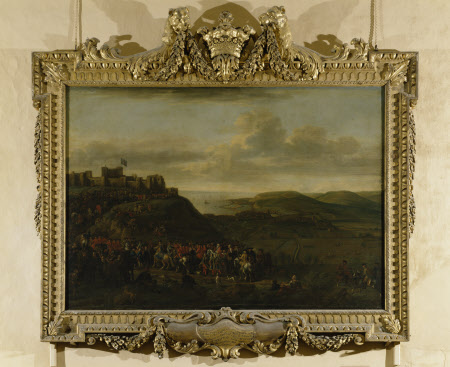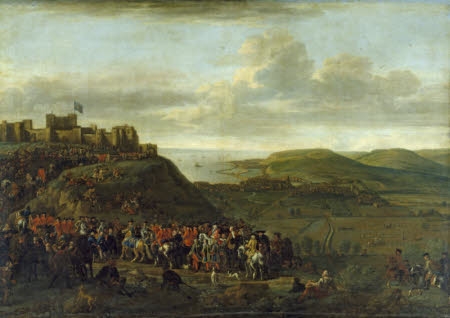View with the Procession of Lionel Sackville, 1st Duke of Dorset (1688-1765) returning to Dover Castle after taking the Oath of Office of Lord Warden of the Cinque Ports
John Wootton (Snitterfield c.1682 – London 1764)
Category
Art / Oil paintings
Date
1727 (signed and dated)
Materials
Oil on canvas
Measurements
2184 x 3048 mm (86 x 120 in)
Place of origin
England
Order this imageCollection
Knole, Kent
NT 129729
Caption
John Wootton is probably best known for his paintings of sporting subjects, but he also painted battle scenes and various landscapes. Painted in 1727, soon after the 1st Duke was appointed Lord Warden for the third time, this landscape takes its viewpoint from behind Dover Castle in Kent, with the town of Dover in the background. The splendid contemporary frame, in the style of William Kent, is decorated with the Sackville leopards and a heraldic motif from the Sackville coat of arms.
Summary
Oil painting on canvas, View with the Procession of Lionel Sackville, 1st Duke of Dorset (1688-1765) returning to Dover Castle after taking the Oath of Office of Lord Warden of the Cinque Ports by John Wootton (Snitterfield c.1682 – London 1765), signed and dated: I. Wootton Fecit 1727. The inscription on the frame reads: A Prospect of Dover Castle, with the Town, / Harbour and Country adjacent, together / with the Procession of the Lord Warden, in his / return to the Castle, after having taken the / Seriment or Oath of Office, at a COURT / of SHIPWAY held upon / Bradenstone Hill / for that purpose. This landscape shows a view of Dover Castle (Kent), overlooking the town and harbour. The procession of the Lord Warden in the foreground moves towards the castle. The 1st Duke of Dorset, in a pink coat and wearing the Order of the Garter (accorded 1714) is attended by soldiers and horsemen and has attracted a crowd of onlookers. At the rear of the procession is the Reverend Maximilian Buck (identifiable from van der Gucht’s Group in the Steward’s Room at Knole) to whom the Duke later gave the living of Kemsing-cum-Seal. Lionel Cranfield Sackville (1688 – 1765) succeeded his father as 7th Earl in 1706 and was created Duke of Dorset in 1720. He was intermittently (1708 – 1713, 1714 – 1717, 4 January 1727/28 – 1730[?]) Constable of Dover Castle and Warden of the Cinque Ports, until 1757 when his appointments were made permanent. He was described variously by the Earl of Shelburne in 1875: “in all respects a perfect English courtier and nothing else … He had the good fortune to come into the world with the Whigs, and partook of their good fortune to his death. He never had an opinion about public matters …. He preserved to the last the good breeding, decency of manners, and dignity of exterior deportment of Queen Anne’s time, never departing from his style of gravity and ceremony” and Horace Walpole as having “the greatest dignity in his appearance, [he] was in private the greatest lover of low humour and buffoonery” and by Swift in 1727: “I do not know a more agreeable person in conversation, one more easy or of better taste, with greater variety of knowledge, than the Duke of Dorset.” Yet, the 1st Duke must have disappointed a number of the expectations aroused by being the son of the so much more gifted and appealing 6th Earl, including those of Matthew Prior, who began his dedication to the then still Earl of Dorset of his Poems of Several Occasions (1708), with the Virgilian invocation: “Tu Marcellus eris, - Our Eyes and our hearts are turned on You …..” His governmental posts included two appointments as Lord Steward of the Household 1725 – 1730 & 1737 – 45, and two as Lord-Lieutenant of Ireland (1730-37 & 1750 – 55). He married Elizabeth Colyear, daughter of General Colyear and of James II’s former mistress, Catherine Sedley, Countess of Dorchester, in 1708/9. She, who was born in 1686, outlived him, dying in 1768. They had three sons – Charles (1711 – 69), later 2nd Duke; Lord John Sackville (1713 – 65), father of the 3rd Duke; and Lord George Sackville (1716 – 85), who assumed the name of Germain on inheriting and Drayton from Lady Betty, and who was created Viscount Sackville of Drayton – and three daughters: the Ladies Anne (d.1721 aet. 11); Elizabeth (m. 1726 Thos., 2nd Vt. Weymouth; d. 1729).
Provenance
Recorded in the Great Hall in 1817; purchased by the National Trust from the Trustees of Knole with the help of the National Heritage Memorial Fund in 1988
Credit line
Knole, The Sackville Collection (acquired with the help of the National Heritage Memorial Fund and transferred to the National Trust in 1988)
Marks and inscriptions
Recto: Inscrobed on frame: A Prospect of Dover Castle, with the Town, / Harbour and Country adjacent, together / with the Procession of the Lord Warden, in his / return to the Castle, after having taken the / Seriment or Oath of Office, at a COURT / of SHIPWAY held upon / Bradenstone Hill / for that purpose.
Makers and roles
John Wootton (Snitterfield c.1682 – London 1764), artist
References
Harris 1979 John Harris, The Artist and the Country House. A History of Country House and Garden View Painting in Britain 1540-1870, London 1979, no. 243 Moore 2015, Peter Moore, 'John Wootton: Painter of Landscapes and other Subjects' in National Trust Historic House & Collections Annual (Apollo) 2015, pp. 26 - 33, fig. 1 & 2

